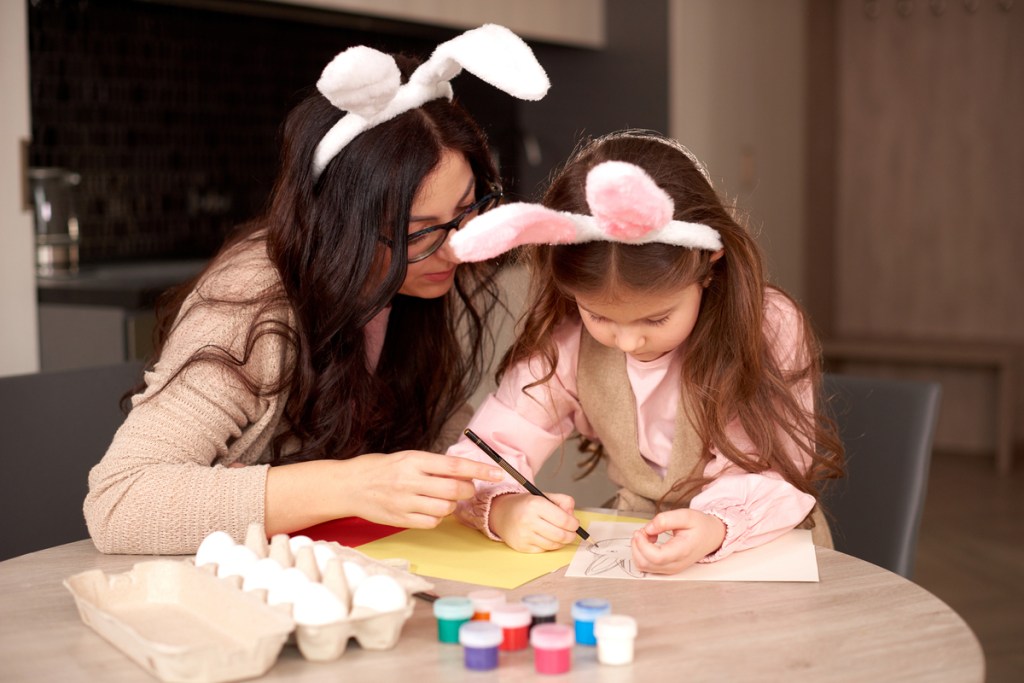Any time a holiday comes up, parents everywhere have to come up with a craft with the theme for that holiday. We learn how to draw Christmas trees and the most perfect hearts for Valentine’s Day. If the thought of having to draw an animal makes you sweat a little bit with Easter coming up, let us be of assistance. It’s going to be all Easter bunnies all month long. With a little help, your bunnies will look more Easter fun and less Halloween scary.

How do you draw an easy Easter Bunny?
We know not everyone is an exceptional artist. But guess what? Kids just want it to look remotely like it’s supposed to, and they will think it’s great. Don’t worry too much about perfection. If you make one ear larger than the other, turn it into a floppy ear. If one little paw doesn’t come out right, draw a carrot over it. Kids only care that you are spending time with them and doing something together.
Knowing how to draw an Easter bunny can be broken down by using circles and ovals. Lots of arched lines make drawing a quick bunny easy for parents and kids. Think more cursive flowing lines and less harsh print straight lines. If you have older kids and they say anything about your skills, make sure you have them draw one and see whose bunny looks more like a bunny. Or have everyone in the family try their best to draw this how-to and see whose comes out looking the most like it.
How do you draw an easy bunny step by step?
For this super easy bunny, it doesn’t matter which way you have your paper, or even what color paper you use. If you plan on coloring it or having your kids color it, you will want to find white paper though.
The steps
For the head
- Draw a circular shape for the head: it doesn’t have to be an exact circle so don’t worry.
- Then draw smaller circles or ovals for the eyes: these are going to be filled in, like bigger dots.
- For the nose, draw your cutest heart.
- Draw a regular “J” and a backward one coming out of the bottom point of the heart.
- For whiskers just add three slightly curved lines coming out of each of the cheeks.
- One ear will be straight up by drawing two longer arches connecting at the top.
- The other ear has to be floppy so make one longer, more curved arch that ends in a point.
- Then make another arch from that point but only meet the first arch halfway.
- Connect that arch from that point to the head.
For the body
- Draw two curved lines next to each other that start and end on the edge of the paper.
- You can add some toes by drawing two short, horizontal lines on the inside of the outer edges.
- Connect the head to the feet by drawing curved lines.
- The wider or more apart the lines are, the fluffier the bunny will look.
- Draw two more curved lines, starting from the head just apart from the body lines to about halfway down the body for the arms.
- Add a little tail by drawing a cloud-like shape on either side of the bunny from the bottom of the body to the side of the foot.
How do you draw a realistic Easter Bunny?
If you want to draw a more realistic bunny, but don’t think you can get beyond the cartoon-style version, we have you covered. We found the easiest, fastest (under two minutes) YouTube video that takes you from two basic circular shapes to an adorable and realistic shaggy bunny.
We had to watch it twice just to believe that it could be that simple. While the last step did seem to jump a bit for us, our bunny actually looked like a bunny. The trick to make a realistic bunny is to draw the fur with frequent shorter lines for the outline instead of solid lines.
If you really want to amaze the kids and show you are the bunny drawing boss, there is a great YouTube video that’s fifteen minutes long and the results are stunning. Maybe practice a few times before you show off to the kids.

How do you draw an Easter bunny out of an egg?
Drawing a cute little bunny popping out of an Easter egg is a classic favorite. And it is easier to draw than you’d think. All you need to do is draw the cracked egg and then you can take the step-by-step instructions of how to draw an easy Easter bunny and stop after you have the head done.
To draw the cracked egg
- Draw a half oval on the bottom of the page with the open end facing the top of the page: basically, draw a giant “U”.
- Connect the open ends with a “W” pattern.
- Draw the bunny face coming out of the egg.
- Decorate the egg with any pattern you like.
See? We told you it wouldn’t be that bad. If you want to try your hand at a bit more detail, there is a YouTube video that isn’t too hard to follow.
With our easy-to-follow steps, you and your children can draw as many cotton-tailed buddies as you’d like. Sure, printouts are easy, but having a contest to see who drew the silliest, craziest, or most realistic Easter bunny in the family is way more entertaining. And sometimes, it’s even better if they turn out just a little bit terrible.



